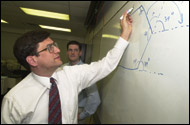
Robert Gane, left, with David Sacochis.
Photo by Evan Cantwell
Three's a Charm
Engineering alums join forces to teach Mason freshman course
By Robin Herron
Mentoring is part of the professional code in the engineering fields, and several George Mason alumni take that responsibility seriously.
Robert Gagne, BS Urban Systems Engineering '94 and MS Urban Systems Engineering '98, and David Shacochis, BS Urban Systems Engineering '94 and MBA '00, met at George Mason as undergraduates. In 1998 while they were working at the same company, they were tapped to team-teach the freshman-level Engineering Computer Graphics course. They've been doing it ever since. Deniz Callahan, BS Urban Systems Engineering '98, joined the team last fall.
Gagne, a program project manager for the Washington Metropolitan Area Transit Authority Parking Structures Program; Shacochis, regional manager for business development at Savvis Communications in Herndon, Virginia; and Callahan, a civil engineer for BC Consultants Inc. in Fairfax, are all members of the Alumni Association's Civil Engineering Chapter.
“As George Mason alumni, we bring a real-world sensibility to the subject matter,” says Shacochis, the team's leader. “Our lessons are often shaped by experiences we've had in the days and weeks leading up to class. Students really respond to that relevance.”
Engineering Computer Graphics is one of the fastest growing courses in the Civil, Environmental, and Infrastructure Engineering (CEIE) undergraduate curriculum. Since the team has been teaching, the number of CEIE majors registering for the course has increased by about 8 percent per year. In addition, the class size has been expanded and a teaching assistant was recently assigned to the course.
“Our department is much more than an academic unit,” says Tomasz Arciszewski, CEIE chair. “We are part of a Northern Virginia community of our students, instructors, and practicing engineers who work together to improve our academic programs and subsequently the quality of our graduates. Our students are highly appreciative of the fact that their instructors—our former students and now successful engineers—want to work with them, share their knowledge, and ultimately help them succeed in the job market.”
This particular course plays a critical role in attracting and retaining students within the CEIE program, Shacochis feels. “Sometimes, in the midst of all their core math and science requirements, it's important to remind students why they were attracted to engineering design in the first place,” he says. “Engineering Computer Graphics allows us to help freshmen develop critical skills for success in their career. As alumni ourselves, we're thrilled to provide that kind of support to our university. ”
Students who pass the course can apply their skills in a variety of future scenarios. “We've had students leave this course and immediately land drafting internships with local design firms,” Gagne points out. “We assign a large number of practical, hands-on exercises that allow students to build their expertise over the course of the semester. The class culminates in a team-based design project, where students solve an engineering design problem using computer graphics to communicate their results.”
Engineering alumni find that their paths often cross professionally, even if they didn't know one another while going through school. For example, Callahan didn't know Gagne or Shacochis when he was an undergraduate at George Mason. “We became colleagues and friends in 1998 when I began working at BC Consultants,” Callahan says. “Dave and Bob have since changed jobs; however, we have remained in contact over the years.
“I thought it would be great to return to Mason and give back by way of teaching part time. I've very much enjoyed helping teach so far and plan to continue. Dave, Bob, and I bring different experience from our professional careers into the classroom, and the students are eager to learn how computer-aided design is used in each of our related industries.”
Gagne adds, “I continue to teach because I enjoy the interaction with young engineering students. Their perspective on life renews my energy and provides an avenue for me to pass along some small amount of my lessons learned as a practicing professional and continue to be part of academic life.”
